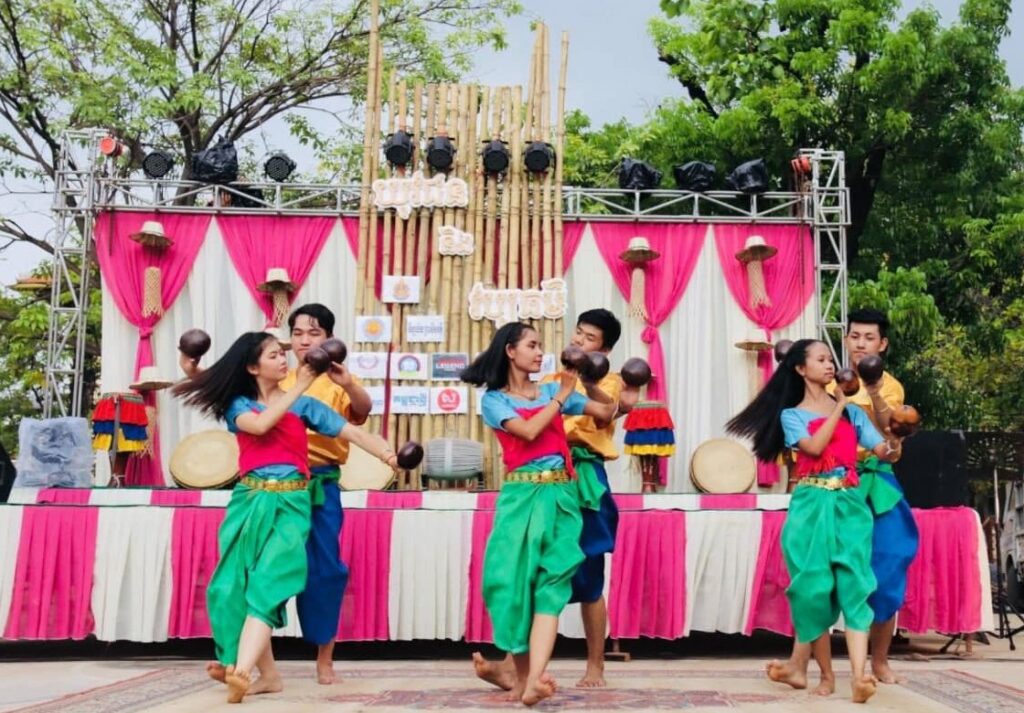កម្ពុជា សម្បូណ៌ទៅដោយដើមដូង ដែលជាផ្នែកមួយនៃធនធានកសិកម្មរបស់ប្រទេស។ ដើមនិងផ្លែដូង មានសារៈសំខាន់ក្នុងការទ្រទ្រង់ជីវភាពរស់នៅរបស់ប្រជាជនកសិករខ្មែរ ហើយក៏ជាលក្ខណៈពិសេសមួយរបស់ភូមិខ្មែរផងដែរ។ បើមើលពីចម្ងាយទៅ គេឃើញដើមដូងដុះខ្ពស់ផុត លើសពីដើមឈើឯទៀតៗនៅក្នុងភូមិ ដែលហាក់ដូចជាផ្តល់ភាពស្ងប់ស្ងាត់សុខដុមរមនា ដល់ភូមិស្ថាននិងប្រជាជន ក៏ដូចជាជម្រកនៃជីវិតមនុស្សនិងសត្វទៀតផង។
នៅពេលមានបុណ្យទានផ្សេងៗ គេយកធាងនិងស្លឹកដូងមកកាត់ធ្វើទៅជាគ្រៀងតុបតែងលម្អដើម្បីញ៉ាំងពិធីបុណ្យឱ្យមានសម្ផស្សស្រស់ស្រាយរីករាយអធឹកអធម។ ខ្មែរយើងតែងតែនិយាយថា ដើមដូងជានិមិត្តរូបនៃភាពស្វាគមន៍។ អ្នកធ្វើដំណើរឆ្ងាយពីភូមិមួយទៅភូមិមួយ នឿយហត់អស់កម្លាំង ជួនកាលគេក៏ឈប់សម្រាកនៅក្រោមដើមដូងមុននឹងបន្តដំណើររបស់គេទៅមុខទៀត។ ដោយអស់កម្លាំងផង ប្រសិនបើគេបានទទួលទានទឹកដូងមួយក្អឹកឬពីរ គេនឹងមានកម្លាំងនិងថាមពលក្នុងការធ្វើដំណើរទៅទៀត។
ក្រោយពីផ្លែដូងដែលនៅលើដើមទុំហើយ វានឹងជ្រុះមកដី។ គេរើសប្រមូលផ្លែទាំងនោះយកមកធ្វើម្ហូបនិងបង្អែមដែលគេចូលចិត្ត។ គេយកលលាដ៍ដូងដែលគេយកទឹកនិងសាច់ចេញអស់ហើយមកធ្វើជាគ្រឿងតុបតែងលម្អគេហដ្ឋានរបស់គេ។ សិល្បករ ដែលផ្តិតគំនិតពីធម្មជាតិ ច្នៃត្រឡោកដូងឱ្យទៅជាឧបករណ៍សម្រាប់ល្បែងប្រជាប្រិយនិងប្រពៃណីផ្សេងៗ។ អ្នកស្រុកនៅខេត្តស្វាយរៀង លេងល្បែងប្រជាប្រិយមួយមានឈ្មោះថា «ល្បែងគោះត្រឡោក» ដែលគេធ្លាប់សម្តែងនៅក្នុងឱកាសផ្សេងៗ តែជារឿយៗនៅក្នុងពិធីអាពាហ៍ពិពាហ៍ ដូចជាពិធីភ្ជាប់ពាក្យនិងហែកូនកំលោះពីគេហដ្ឋានខាងប្រុសទៅខាងស្រី។ សៀវភៅ«ល្បែងប្រជាប្រិយខ្មែរ» អះអាងថា ល្បែងគោះត្រឡោកកាលពីសម័យដើមលេងដោយអ្នកលេងតែម្នាក់ប៉ុណ្ណោះ។ ដោយឡែក សិល្បករសិល្បការិនីនៃសាកលវិទ្យាល័យភូមិន្ទវិចិត្រសិល្បៈ ក៏បានយកត្រឡោកដូងមកច្នៃនិងបង្កើតទៅជារបាំត្រឡោក ឬ របាំគោះត្រឡោកដែលមានសម្តែងរហូតមកដល់សព្វថ្ងៃនេះ។ របាំត្រឡោកបច្ចុប្បន្ន មានអ្នករាំស្រីនិងប្រុសរាំជាគូ។ ប្រហែលជាដោយសារ ល្បែងគោះត្រឡោកពីដើមត្រូវបានគេប្រើនៅក្នុងពិធីអាពាហ៍ពិពាហ៍ ទើបរបាំនេះចាប់ផ្តើមដោយបទភ្លេងអាពាហ៍ពិពាហ៍មួយហៅថា «សំពោង» ហើយបន្តភ្ជាប់និងបញ្ចប់ដោយចម្រៀងគោះត្រឡោក។ ពាក្យពេចន៍នៃចម្រៀងក្នុងរបាំត្រឡោកបង្កប់នូវអត្ថន័យខ្លឹមសារអប់រំ លាតត្រដាងអំពីជីវិត ធម្មជាតិ និងមនោសញ្ចេតនារបស់ប្រជាកសិករខ្មែរ។
—————————————-
COCONUT-SHELL DANCE
Cambodia is filled with coconut trees that make up one of the main agricultural resources of the country. They serve as a means of sustenance for the Khmer country folk, and they are particular characteristics of Khmer village. From a distance, one can see coconut trees rise above other trees, hiding peaceful houses, and sheltering both human and creature lives.
During national and religious ceremonies, coconut midribs and leaves are cut and fashioned into beautiful decorations to enhance the occasion. It is also said that the coconut trees are symbols of hospitality. Travelers on foot, who walk kilometers from village to village often end up under a coconut tree to catch their breath before they proceed to their destination. Being so tired and exhausted, the travelers appreciate a few sips of coconut water to energize their bodies.
When the fruits are left on the trees to ripen, they fall. People collect coconuts to prepare their favorite delicacies. After the coconut meat is taken, the hard shells are often collected, cut nicely, and polished, making them objects of art for home decoration.
Artists, who are inspired by nature, use coconut shells as instruments for games. From the same inspiration, teachers and students of the Royal University of Fine Arts in Phnom Penh created the Robaim Tralaok or Coconut-shell Dance.
Originating in the province of Svay Rieng, a popular game called Lbaeng Kuoh Tralaok (Hitting the Coconut-shell Game) provided the idea to use the coconut shells in the present dance that we see today. The Hitting the Coconut-shell Game was played during various ceremonies, but most often during the wedding ceremonies, engagements, or times when the groom is escorted in a procession to the bride’s house. The game was a one-man show then. In the present dance, a group consisting of equal numbers of male and female dancers is required to perform the dance. Perhaps because it was once used in wedding ceremonies, the dance starts with a wedding piece called Sampong, followed by a folk tune to bring the dance to its close. The theme of the present version is didactic, made explicit by what the song conveys. The lyrics depict feelings of our people, the Khmer leaning towards nature and love.
អត្ថបទដើម៖ បណ្ឌិត សំ សំអាង








